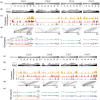Recent parallel speciation in Antirrhinum involved complex haplotypes and multiple adaptive characters
- PMID: 37602497
- PMCID: PMC10947308
- DOI: 10.1111/mec.17101
Recent parallel speciation in Antirrhinum involved complex haplotypes and multiple adaptive characters
Abstract
A role of ecological adaptation in speciation can be obscured by stochastic processes and differences that species accumulate after genetic isolation. One way to identify adaptive characters and their underlying genes is to study cases of speciation involving parallel adaptations. Recently resolved phylogenies reveal that alpine morphology has evolved in parallel in the genus Antirrhinum (snapdragons): first in an early split of an alpine from a lowland lineage and, more recently, from within the lowland lineage to produce closely related sympatric species with contrasting alpine and lowland forms. Here, we find that two of these later diverged sympatric species are differentiated by only around 2% of nuclear loci. Though showing evidence of recent gene flow, the species remain distinct for a suite of morphological characters typical of earlier-diverged alpine or lowland lineages and their morphologies correlate with features of the local landscape, as expected of ecological adaptations. Morphological differences between the two species involve multiple, unlinked genes so that parental character combinations are readily broken up by recombination in hybrids. We detect little evidence for post-pollination barriers to gene flow or recombination, suggesting that genetic isolation related to ecological adaptation is important in maintaining character combinations and might have contributed to parallel speciation. We also find evidence that genes involved in the earlier alpine-lowland split were reused in parallel evolution of alpine species, consistent with introgressive hybridisation, and speculate that many non-ecological barriers to gene flow might have been purged during the process.
Keywords: Antirrhinum; RADseq; adaptation; gene flow; introgression; snapdragon; speciation.
© 2023 The Authors. Molecular Ecology published by John Wiley & Sons Ltd.
Conflict of interest statement
The authors have no conflict of interest to declare.
Figures





References
-
- Bertel, C. , Rešetnik, I. , Frajman, B. , Erschbamer, B. , Hülber, K. , & Schönswetter, P. (2018). Natural selection drives parallel divergence in the mountain plant Heliosperma pusillum s.l. Oikos, 127(9), 1355–1367. 10.1111/oik.05364 - DOI
-
- Billings, W. D. (1974). Adaptations and origins of alpine plants. Arctic and Alpine Research, 6(2), 129–142. 10.1080/00040851.1974.12003769 - DOI
Publication types
MeSH terms
Grants and funding
LinkOut - more resources
Full Text Sources

